March 17 (Raccoon Mountain RV Park): We had a shorter but no less arduous drive from Macon to Chattanooga. For starters, the RV could not fit into our selected gas station and our next try required some fancy maneuvering to park so we could get lunch. Because of this, Chuck did all the driving. As well, the highway took us through downtown Atlanta, with lots of merging traffic.
 Raccoon Mountain is part of the Smokeys – it is certainly nice to be in mountains again after the monotony of the coastal plain. The RV camping part of the campground is basic, but the folks in the office are friendly and the campground is part of a larger complex than includes Raccoon Mountain caverns and several hiking trails. There are lots of birds in the bushes surrounding the campground, and we have been learning to use our binoculars and identify birds.
Raccoon Mountain is part of the Smokeys – it is certainly nice to be in mountains again after the monotony of the coastal plain. The RV camping part of the campground is basic, but the folks in the office are friendly and the campground is part of a larger complex than includes Raccoon Mountain caverns and several hiking trails. There are lots of birds in the bushes surrounding the campground, and we have been learning to use our binoculars and identify birds.
I had 2 work phone calls after we got in, and Chuck had a long work session the following afternoon. We decided to go into Chattanooga for supper and a walk across the historic Walnut Street Bridge.
Chattanooga lies on the Tennessee River. Although it was not the ancestral home of the Cherokees, there was a major Cherokee settlement here and John Ross, who was part Cherokee and identified as such was an important businessman and citizen of the city. Ross’s Landing, a riverside docking facility, was one of the 3 main concentration camps for the Cherokee before they were forced on the “Trail of Tears” to Oklahoma. Today the Tennessee Aquarium overlooks Ross’s Landing.
For a long time, the river was problematic, with treacherous whirlpools and rapids. It was not reliably navigable until it was tamed by the Tennessee Valley Authority in the 1930s. Hence, Chattanooga became a rail center (Chattanooga Choo Choo, anyone?). The river was traversed by ferry. During the Civil War, a pontoon bridge was built to facilitate troop movement across the river. After the war, this was replaced by a “permanent” bridge that cost 3/4 million dollars – a fortune for the time. However, two years after the bridge was completed, a flood brought it down.
 In 1890, a new bridge was built extending Walnut Street to the opposite shore. While other bridges have since been built, the Walnut Street Bridge continued to be used until 1978. For the following decade it was not used, and there were plans to tear it down. However, around 1988 it was resurrected as a historic site, and was refurbished as a pedestrian walkway.
In 1890, a new bridge was built extending Walnut Street to the opposite shore. While other bridges have since been built, the Walnut Street Bridge continued to be used until 1978. For the following decade it was not used, and there were plans to tear it down. However, around 1988 it was resurrected as a historic site, and was refurbished as a pedestrian walkway.
We noted that each plank on the wooden bridge has a small brass plate with a name – I assume this is the equivalent of buying paving stones in historic districts and encouraged local residents to contribute to the project. In any case, on a Friday evening, despite some chill, the bridge was crowded with families, young adults (possibly prom goers), dog walkers, joggers and tourists.
However, after our walk I learned that the bridge is not popular with everyone. It connects the downtown (largely white) with a suburb that used to be popular with African Americans. Sadly, in the 1930s it was the scene of several lynchings.

 Downtown Chattanooga is small, but pretty, especially in the evening and viewed from the bridge. They have perfected the use of floodlights to enhance the scene. One very attractive floodlit building is part parking garage, part climbing wall – the building with green lights to the right. Closer to the water are the glass roofs of the Tennessee Aquarium buildings, and at the downtown end of the Walnut Street Bridge is the Hunter Museum of Modern Art, also with interesting lighting (to the left).
Downtown Chattanooga is small, but pretty, especially in the evening and viewed from the bridge. They have perfected the use of floodlights to enhance the scene. One very attractive floodlit building is part parking garage, part climbing wall – the building with green lights to the right. Closer to the water are the glass roofs of the Tennessee Aquarium buildings, and at the downtown end of the Walnut Street Bridge is the Hunter Museum of Modern Art, also with interesting lighting (to the left).
 The following day we started our sightseeing on Lookout Mountain, a limestone table mountain which overlooks the city from an imposing height. On the city side, the mountainside is a sheer cliff rising from the Tennessee River Valley.
The following day we started our sightseeing on Lookout Mountain, a limestone table mountain which overlooks the city from an imposing height. On the city side, the mountainside is a sheer cliff rising from the Tennessee River Valley.

About half-way up the mountain is a limestone cavern that was used by both the native Americans and the early settlers. In 1905 a rail line was built into the side of the mountain and the mouth of the cavern was sealed as part of the construction, In 1920 a local caver, Leo Lambert, decided to sink a shaft down to the cavern and re-open it as a tourist attraction. During the drilling, a passageway about 18 inches high was discovered. Lambert and a friend traversed this passageway for 7 hours on hands and knees until it opened to a larger passage through which they could walk. At the end of this passage, they found a 145 foot high waterfall. In all, this first traverse of the cavern and back took them 17 hours. Lambert then did a second visit with his wife Ruby (who must have been an enthusiastic spelunker herself, to do this many hours of crawling with only a headlamp for light) and then named the falls after her.
 Lambert re-opened the original cavern as a tourist attraction and then blasted out enough of the new cavern to admit tourists. However, the original cavern must not be very interesting, because only the Ruby Falls cavern is now open. It is now accessed by an elevator ride deep into the mountain and a walk of almost an hour through the cave (all of it lit and most of it wide enough to walk two or three abreast and at least 65″ high. (I can vouch for the height because although Chuck occasionally had to duck, I never did.)
Lambert re-opened the original cavern as a tourist attraction and then blasted out enough of the new cavern to admit tourists. However, the original cavern must not be very interesting, because only the Ruby Falls cavern is now open. It is now accessed by an elevator ride deep into the mountain and a walk of almost an hour through the cave (all of it lit and most of it wide enough to walk two or three abreast and at least 65″ high. (I can vouch for the height because although Chuck occasionally had to duck, I never did.)
The cave has dramatic colored lighting and a few interesting rock formations which are lovely but similar to other limestone caverns in central Pennsylvania (e.g. Lincoln Caverns or Penns Cave) and elsewhere. However, Ruby Falls is truly an amazing sight – especially with the light show above. We highly recommend this cavern.
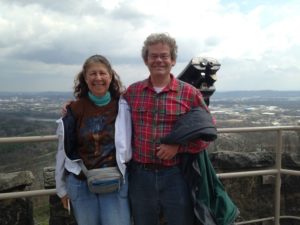 At the end of the tour, upon exiting the elevator, you can climb a tower to get a terrific view over the Tennessee River Valley and Chattanooga.
At the end of the tour, upon exiting the elevator, you can climb a tower to get a terrific view over the Tennessee River Valley and Chattanooga.

After the cave tour, we continued up the mountain to Rock City – a natural maze of deep crevasses in the limestone. Although the Disney-like entrance was a bit off-putting, once we started the walk we thoroughly enjoyed it. This part of Overlook Mountain is near the edge overlooking the Tennessee Valley and Chattanooga. The geology consists of huge limestone slabs, perhaps 30 feet tall, separated by crevasses a few feet wide. 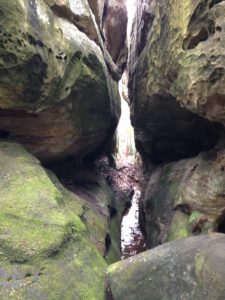 A numbered path takes you through or over the crevasses. Whenever you are on the top of the slabs, you have a spectacular view over the valley.
A numbered path takes you through or over the crevasses. Whenever you are on the top of the slabs, you have a spectacular view over the valley.

The walk is enhanced by lovely plantings of native flora. As well, there is piped in music – sufficiently tasteful that I felt that it enhanced the experience. The venue was celebrating St. Patrick’s Day, so there were some Irish cultural events, and (for some reason) Scottish bagpipers.
 A somewhat bizarre aspect of Rock City is due to the founder’s love of German folklore. The venue is decorated with hundreds of garden gnomes, (no pictures included) which is just as weird as it sounds.
A somewhat bizarre aspect of Rock City is due to the founder’s love of German folklore. The venue is decorated with hundreds of garden gnomes, (no pictures included) which is just as weird as it sounds.
 As well, one tunnel is filled with scenes from German fairy tales, all painted in glowing “black light” fluorescent color.
As well, one tunnel is filled with scenes from German fairy tales, all painted in glowing “black light” fluorescent color.

At the very top of Rock City is a point from which you are supposed to be able to see 6 states – the flags are shown. A lot of mountains are visible, so I think it is possible. It is a lovely spot to stop and have a drink (and to watch a wedding ceremony).

The artificial waterfall at Rock City was dyed green for St. Patrick’s Day – a rather bizarre effect.

Our final day in Chattanooga was quite intense, as we tried to cover everything else that sounded interesting, while also getting some work done.
First on the list was a tour of the Raccoon Mountain cavern. Although I was tempted to do a “wild cave” tour through the undeveloped part of the cavern, in the end I decided that I was not mentally prepared to “belly crawl” through the tight spots with no light but a headlamp. The caverns offer wild cave tours up to 6 hours for the adventurous. Instead, we both took the “Crystal Cavern” tour through the developed part of the cave.
 We have been to several caves in PA, including our local Penn’s Cave. The rock formations at Raccoon Mountain are far more spectacular than anything I have seen previously. As well, there are 3 species of salamander (we saw two of these), crickets, spiders and bats in the caves (although we did not see the spiders or bats).
We have been to several caves in PA, including our local Penn’s Cave. The rock formations at Raccoon Mountain are far more spectacular than anything I have seen previously. As well, there are 3 species of salamander (we saw two of these), crickets, spiders and bats in the caves (although we did not see the spiders or bats). 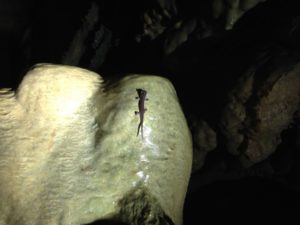
The formations are lit up with white light, which I prefer. The tour is relatively short, but every inch of the route is filled with stalactites, stalagmites, columns, flowstone, ponds, and other formations.
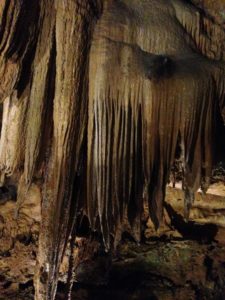 As
As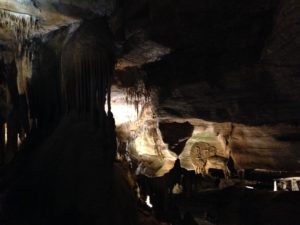
The cave was first explored (and then protected) by spelunker Leo Lambert, so everything is intact except for where drilling was done to develop the cave.
The tour of Raccoon Mountain’s “Crystal Cavern” is only 45 minutes, but since the rock formations start about 3 feet from the entrance, that is sufficient. This is really a cave worth seeing.
 We next headed off to the “Towing and Recovery Museum” which is devoted to tow trucks. Chattanooga auto mechanic Holmes decided that it would be more efficient to bring cars to his shop for repairs, rather than to do the work roadside. He fitted out a Ford truck with a hoist, and created the first tow truck. The museum is small, but is fitted out with a number of antique tow trucks and a lot of historical notes.
We next headed off to the “Towing and Recovery Museum” which is devoted to tow trucks. Chattanooga auto mechanic Holmes decided that it would be more efficient to bring cars to his shop for repairs, rather than to do the work roadside. He fitted out a Ford truck with a hoist, and created the first tow truck. The museum is small, but is fitted out with a number of antique tow trucks and a lot of historical notes. One aspect that I enjoyed was that for each truck, the details of the restoration was included.
One aspect that I enjoyed was that for each truck, the details of the restoration was included. 

 In many cases, the original truck is not on display, but rather was recreated from vintage parts. The work involved was brought to our attention a few days later in Corbin, where we saw a decaying model T sitting in a car lot.
In many cases, the original truck is not on display, but rather was recreated from vintage parts. The work involved was brought to our attention a few days later in Corbin, where we saw a decaying model T sitting in a car lot.
I liked this beautifully painted truck that had the US flag on one side and the Canadian on the other.
For some reason this museum, like the Truck and Tractor Museum we saw near Petersburg, had many display cases of toy and model cars and trucks as well.
 After that we had about 3 hours to see the Tennessee Aquarium in downtown Chattanooga. The Aquarium is actually housed in 3 buildings and an IMAX theatre. One building is devoted to educational displays (no live fish). One building has a huge aquarium of ocean fish, along with smaller tanks that contain other displays (such as the jelly fish tanks).
After that we had about 3 hours to see the Tennessee Aquarium in downtown Chattanooga. The Aquarium is actually housed in 3 buildings and an IMAX theatre. One building is devoted to educational displays (no live fish). One building has a huge aquarium of ocean fish, along with smaller tanks that contain other displays (such as the jelly fish tanks).

The top floor is devoted to the flora and fauna of Madagascar and one of our favorite primate families – lemurs. It had some unique animals I have not seen before including spotted fresh water rays from Madagascar. As well, there was a large display about sea horses and a relative called sea dragons.
 The third building is devoted to freshwater fish and has a huge aquarium representing river life. The entrance, however, is devoted to two species of penguin, which were enjoying dinner when we arrived.
The third building is devoted to freshwater fish and has a huge aquarium representing river life. The entrance, however, is devoted to two species of penguin, which were enjoying dinner when we arrived.
All I can say, in summary, is that it can be very fascinating to watch masses of really big fish swim around. The Tennessee Aquarium certainly delivered, and had lots of other great displays as well.
